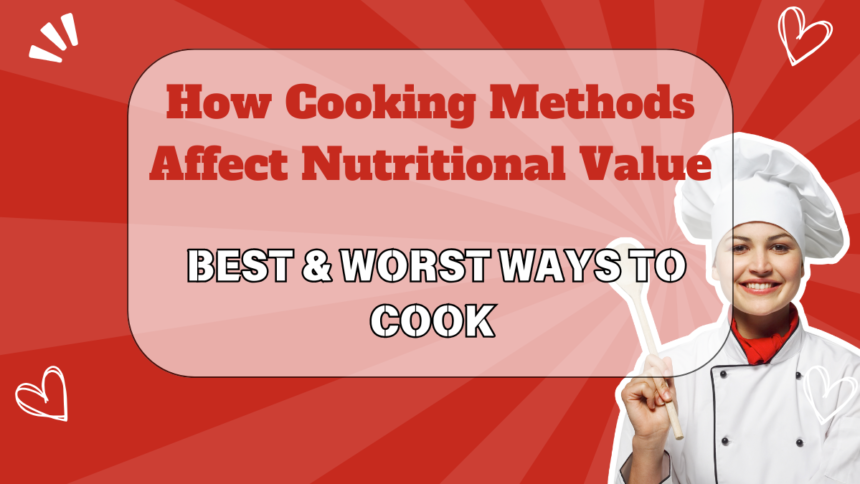Nutritional Value: Best & Worst Ways to Cook
Have you ever wondered why some cooking methods leave your veggies limp and lifeless, while others keep them vibrant and full of nutrients? The way we cook our food doesn’t just affect taste and texture—it can make or break its nutritional value. From boiling away vitamins to grilling locking in antioxidants, the techniques we use in the kitchen play a huge role in how nourishing our meals really are.
In this post, we’ll explore how different cooking methods impact the nutrients in your food, the best (and worst) ways to prepare meals for maximum health benefits, and simple tips to boost nutrient absorption. Whether you’re a health-conscious home cook or just looking to get the most out of your meals, this guide will help you make smarter choices in the kitchen.
How Heat Affects Nutrients in Food
Not all nutrients react the same way to heat. Some vitamins, like vitamin C and B vitamins, are heat-sensitive and can break down when exposed to high temperatures. Others, like lycopene in tomatoes or beta-carotene in carrots, actually become more bioavailable when cooked. Understanding these differences can help you choose the best cooking method for each ingredient.
The Best Cooking Methods for Preserving Nutrients
1. Steaming
Why it’s great: Steaming is one of the gentlest cooking methods, preserving water-soluble vitamins (like vitamin C and folate) that can be lost in boiling water. It also keeps vegetables crisp and colorful.
Best for: Broccoli, spinach, carrots, and asparagus.
Tip: Use minimal water and avoid overcooking to retain nutrients.
2. Stir-Frying
Why it’s great: Quick cooking at high heat helps retain nutrients while adding flavor with healthy fats (like olive or avocado oil), which can improve absorption of fat-soluble vitamins (A, D, E, K).
Best for: Bell peppers, snap peas, mushrooms, and leafy greens.
Tip: Cook in small batches to avoid steaming instead of frying.
3. Microwaving (Yes, Really!)
Why it’s great: Contrary to popular belief, microwaving can preserve nutrients better than boiling because it uses minimal water and short cooking times.
Best for: Frozen veggies, sweet potatoes, and fish.
Tip: Cover food with a damp paper towel to lock in moisture.
4. Raw (When It Makes Sense)
Why it’s great: Some foods, like berries, cucumbers, and nuts, are best eaten raw to maximize their enzyme and nutrient content.
Best for: Salads, smoothies, and snacks.
Tip: Pair raw veggies with healthy fats (like avocado or olive oil) to enhance nutrient absorption.
Video Credits
The Worst Cooking Methods for Nutrient Loss
1. Boiling (Especially for Too Long)
Why it’s bad: Water-soluble vitamins (B vitamins, vitamin C) leach into the water, which is often discarded. Overboiling can also destroy enzymes and antioxidants.
Fix: If you must boil, use the leftover water for soups or sauces.
2. Deep-Frying
Why it’s bad: High heat and oil oxidation can degrade nutrients and create harmful compounds like acrylamide.
Fix: Opt for air-frying or pan-frying with minimal oil.
3. Over-Grilling or Charring
Why it’s bad: While grilling can enhance flavors, charring meat or veggies can produce carcinogenic compounds like heterocyclic amines (HCAs) and polycyclic aromatic hydrocarbons (PAHs).
Fix: Marinate meats before grilling (herbs and spices reduce harmful compounds) and avoid direct flames.
Tips to Improve Nutrient Absorption from Your Food
- Pair Nutrients Smartly: Combine iron-rich foods (spinach) with vitamin C (lemon juice) to boost absorption.
- Use Healthy Fats: Cook veggies with olive oil or avocado to absorb fat-soluble vitamins better.
- Don’t Overcook: Keep cooking times short to preserve heat-sensitive nutrients.
- Store Properly: Some nutrients degrade when exposed to light and air—store produce in airtight containers.
Final Thoughts
The way you cook your food can be just as important as what you eat. By choosing gentler methods like steaming, stir-frying, or even microwaving, you can keep more nutrients intact while still enjoying delicious meals. On the flip side, overcooking, deep-frying, or charring can strip away health benefits and even introduce harmful compounds.
Next time you’re in the kitchen, think about how your cooking style impacts your meal’s nutritional value—small changes can make a big difference in your overall health!
What’s your go-to cooking method for keeping meals nutritious? Share your tips in the comments below


